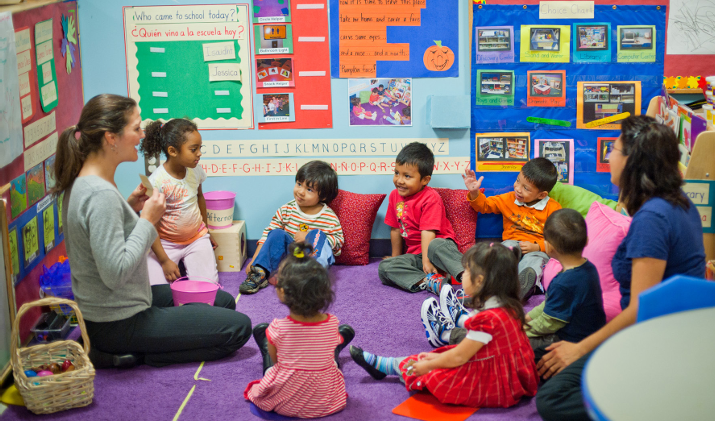California’s English Learner (ELs) student population is not a monolith: A spotlight on Asian American, Native Hawaiian, & Pacific Islander ELs
Most Americans know that the U.S. school population is rapidly changing and that increasing numbers of students are English Learners (ELs). What they may not know is that this segment is now the fastest-growing demographic in our school system, and they come from incredibly diverse backgrounds, so their academic success hinges on tailored cultural and linguistic approaches. To ensure all students in our country have a real and equitable opportunity to learn, grow, and thrive, the U.S. education system needs to expand opportunities and remove barriers that create unequal challenges for students.
Nearly five decades ago, the U.S. Supreme Court ruled, in Lau v. Nichols, the landmark civil rights U.S. Supreme Court decision which unanimously decided that public schools in San Francisco failed to provide thousands of non-English-speaking students of Chinese ancestry supplemental language instruction. The case established that non-English speakers were denied access to a meaningful education and that “equal treatment” does not mean “equal opportunity.” While the case was brought on by parents of non-English-speaking students of Chinese ancestry, this ruling greatly benefits English Learners from all languages, cultures, ethnicities, and nationalities. History continues to show that advancing the civil rights of Latino students is tied to the civil rights of all students of color, therefore, and that groups like UnidosUS must continue to work across multi-racial coalitions to advance the civil rights of all students.
Even though California has the highest number of English Learners (ELs) in the nation, comprising 18% of the state’s total public elementary and secondary school enrollment in the fall of 2021, the state’s EL student population is linguistically and culturally diverse. Understanding this diversity is critical to developing a more culturally and linguistically responsive system that considers diverse languages, ethnic and cultural subgroups, historical context, socioeconomic barriers, and the structural and institutional barriers that stand in the way.
 In honor of Asian Pacific Islander Heritage Month and as part of our efforts to support English Learners (ELs) in California, UnidosUS joined Asian & Pacific Islander American Scholars (APIA Scholars) and Californians Together in Sacramento, CA, to highlight the new APIA Scholars report Asian American, Native Hawaiian, & Pacific Islander English Learners: A Focus on California. Their report focused on the unique needs of Asian American, Native Hawaiian, and Pacific Islander (AANHPI) EL students in the state.
In honor of Asian Pacific Islander Heritage Month and as part of our efforts to support English Learners (ELs) in California, UnidosUS joined Asian & Pacific Islander American Scholars (APIA Scholars) and Californians Together in Sacramento, CA, to highlight the new APIA Scholars report Asian American, Native Hawaiian, & Pacific Islander English Learners: A Focus on California. Their report focused on the unique needs of Asian American, Native Hawaiian, and Pacific Islander (AANHPI) EL students in the state.
“There is so much intersection across the research and recommendations among our three organizations. We are grateful for this opportunity to present with our esteemed colleagues at UnidosUS and CalTog and look forward to more collaboration in the future,” said Jo Ann Paanio, Senior Director of Policy and Advocacy of APIA Scholars.
Importance of accurate data
The report showed that people of AANHPI heritage represented 15% of the state’s residents and 11.8% of its EL student population and highlighted their incredible linguistic diversity. AANHPI EL students reported 43 different languages and dialects as their primary language spoken at home, with the top five languages being Vietnamese (23,927), Mandarin (20,648), Cantonese (13,683), Filipino (Pilipino and Tagalog) (11,553), and Punjabi (9,375).
Uplifting the diversity of the Asian American, Native Hawaiian, and Pacific Islander (AANHPI) EL student population is critical, given that there is often the misconception that EL students are a monolithic group. Ensuring there is meaningful and disaggregated data of this culturally and linguistically diverse student group, meaning breaking down student data by categories such as racial and ethnic groups, gender, and socioeconomic identity, will provide additional insight on student performance and allow for English Learner (EL) students to be served more equitably.
“A critical facet of understanding the demographic composition of English Learner students is challenging the ways they are often misunderstood, misrepresented, and discussed in education research and policy as a monolithic group,” the report stated.
Language access and storytelling
The report’s authors noted that the stereotype of AANHPI as “model students” who are studious and self-sufficient can lead educators and educational systems to overlook students who do not fit the stereotype. One of the ways to address this is by promoting an asset-based approach in curriculum and pedagogy that centers the strengths of their cultural and linguistic background. The state of California made it easier to do that when it passed Proposition 58 in 2016, which rescinded the controversial Proposition 227 of 1998, a law that largely prohibited the teaching of bilingual and multilingual education.
Now, schools can more easily provide literacy engagement in the home languages of ELs through an asset-based approach, an action the report noted can “uplift a student’s individual lived experiences and can include having more AANHPI narratives represented in the curriculum to combat monolithic and inaccurate representations like the model minority myth and other stereotypes.”
This literacy engagement should cover everything from more inclusive textbooks to classroom libraries with stories and characters reflecting the backgrounds of the diverse EL population, as well as literature in students’ home languages.
Teacher education and representation
The report stated that the state needs to do more to recruit, compensate and sustain multilingual teachers of APIA backgrounds while ensuring that all teachers, regardless of their heritage, are sensitized and culturally prepared to engage California’s diverse population.

“Traditional approaches to teacher professional development have often focused on the technical concepts of teaching like lesson planning, classroom management, and literacy growth,” the report stated. “While these aspects of teacher training and development are essential to the profession, there is a growing need to invest in training teachers to work with culturally and linguistically diverse groups of students.”
“As California’s population and its AANHPI student base become increasingly diverse, the teacher population has not kept pace with the demographic changes. We need to start with more representation and recruitment of AANHPI teachers as well as ongoing training and resources for all teachers,” said Dr. Florie Mendiola, Senior Director of Research and Pacific Island Partnerships of APIA Scholars.
Latino solidarity
In the first quarter of 2023, UnidosUS conducted a series of interviews with members of the UnidosUS Affiliate Network to learn more about their experiences supporting and serving English Learners following multiple years of disrupted learning in California. The findings of these sessions can be found in From Practice to Policy: English Learners and Multilingual Learners in California.
While it is important to step away from a ‘one size fits all’ approach when addressing the needs of EL students, there are solutions that can significantly benefit all EL students. The AANHPI report and the UnidosUS Practice to Policy brief offer similar approaches to effectively support ELs across the state.
UnidosUS California Policy Strategist Viviana Martin acknowledged that many students identifying as Latino also identify as Asian and that California’s 1.1 million ELs, who represent one in five students in that state, face challenges not just with language but with their overall emotional well-being and self-confidence. She said UnidosUS’s listening sessions highlighted how the pandemic exacerbated learning gaps for ELs, leading to a growing call for mental health support.
“It is important for us to identify the similarities across communities while working to uplift the unique needs and solutions of the diverse EL student population.”
Recommendations for better policies and programs
Like UnidosUS, APIA Scholars recognizes that California launched and operates several statewide initiatives that helped to improve support systems for ELs. However, both organizations acknowledge that more must be done to support EL students in reaching their full potential and maximize their contributions to the state and the U.S. economy.
As such, UnidosUS encourages policymakers to support robust funding to build the infrastructure to support English Learners in the long term. This includes addressing the lack of consistent and high-quality data about individual students, such as disaggregating data, and the support they are provided, as well as for programs that can diversify the teacher pipeline through initiatives such as California’s Grow Your Own Programs and Career Technical Education. It also supports investing in social and emotional support for students and educators, as well as content, culturally and linguistically responsive curricula.
In addition, UnidosUS also recommends that school district leaders, administrators, and teachers engage with caretakers and community-based organizations representing ELs and their families in the development and implementation of their policies and programs. Ensuring that those closest to the student, such as a caretaker or members of their community, are involved in their child’s education is key to the child’s success in school.
–Author Julienne Gage is a former UnidosUS Senior Web Content Manager who now serves the organization as a consultant.

